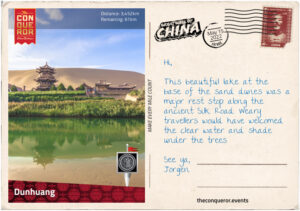Efter helgens bravader, kom det näst sista vykortet på vår vandring på den kinesiska muren.
Snart i mål!

Tjugoåttonde vykortet
The town of Dunhuang is situated in an oasis at the west end of the Hexi Corridor and the start of the Southern Silk Route. On the edge of the city is a crescent-shaped lake called Yueyaquan (aka Crescent Moon Lake) and the Singing Sand Dunes, that emit melodic sounds when the wind blows.
Originally occupied by nomadic tribes, Han Emperor Wu dispatched his military troops to expel them and by 121BC Dunhuang was brought under Han control. The emperor promptly ordered a Great Wall built, which stretched 85mi (136km) in length and consisted of 80 beacon towers. The structure of the wall was a combination of local sand and reeds, compacted together in layers.
Dunhuang, along with Jiuquan, Zhangye and Wuwei, was a frontier garrison town and played an important military role in the safety of both the region and inner China.
It benefited greatly from the Silk Road. As the intersecting city for the three main silk routes, Dunhuang was a key base for water and food supplies and a welcome sight for arriving travellers. The town prospered from the heavy traffic flow until it was plundered and destroyed by the invading Mongols. The town was rebuilt and subsequently brought under the Yuan Dynasty (Mongol Empire).
By the Ming Dynasty, Dunhuang went into decline, as the Silk Road was replaced by the Maritime Silk Route.
South of the city are the sandstone Mogao Caves. Spanning one mile (1.6km) in length, the caves were built from the 4th-14th centuries and filled with frescoes and more than 2,000 Buddha statues. One of the caves was accidentally stumbled upon by a Taoist monk in the 1900s, inside was a vast collection of written works. It is estimated that 15,000 manuscripts in several languages and 1,100 bundles of scrolls were discovered. In 1987 the site was added to the UNESCO World Heritage List.
Today Dunhuang and the Mogao Caves are threatened by the encroaching Kumtag Desert. Centuries of overgrazing has caused the desert to spread and continue expanding. Hopefully a solution can be found soon before precious archaeological sites are swallowed up.